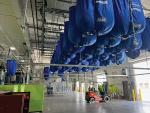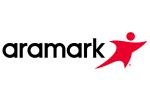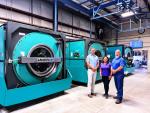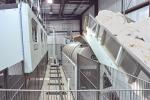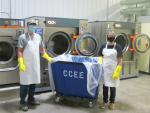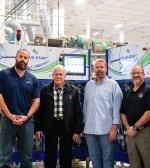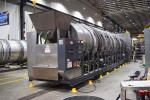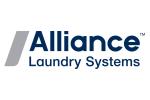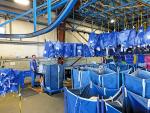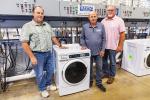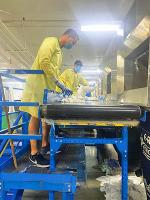OSHKOSH, Wis. — When and why should a laundry transition from open-pocket washers and dryers to an automated continuous batch washer system?
In this article, we’ll offer some timing guidelines for moving into a tunnel system that directly relate to laundry poundage; the benefits a tunnel brings, including amped productivity and savings in labor and utilities; and its anticipated return on investment.
TUNNEL AUTOMATION DESCRIBED
First, it’s important to know how a tunnel works.
A tunnel system—or continuous batch washing system—includes a loading conveyor, batch tunnel washer, water extraction press, shuttle lifting conveyors, pass-through dryers and a master control. The equipment is automated, but simple to use and operate.
One operator places laundry loads onto a loading conveyor, which automatically feeds the tunnel washer. The goods travel through each tunnel module, where linens are pre-washed, washed and rinsed according to how the modules are programmed.
The loads are then run through a press where majority of the water retained is removed.
At this point, the laundry resembles a “cake,” which is then automatically shuttled into an open dryer.
From there, loads are automatically unloaded for folding or ironing, depending on what’s being washed and dried. Through this entire process, the master control tracks and displays load locations, customer names, product categories, weights, etc.
The space required depends on the size of the tunnel washer and the number of modules you select. Girbau Industrial offers tunnels in five to 14 modules in 110-pound capacities.
A five-module tunnel system that processes 2,000 laundry pounds per hour might occupy a space as small as 25 by 50 feet.
WHEN TO INVEST IN A TUNNEL
A tunnel is a big investment, but even laundries processing just 1,000 laundry pounds per hour can benefit in terms of labor, efficiency and productivity.
It’s important to know that not all batch tunnel washers are configured for high-volume productivity. For example, we can configure five-module tunnels with all the features and efficiencies of larger batch tunnels.
These tunnels offer double-drum flexibility and programmability by module. Plus, you can continue to modify them once they are installed for capabilities including water reuse, filtration, heat reclamation and ozone sanitization.
Brightwater Laundry, in Sevierville, Tennessee, launched operations with open-pocket washers and dryers but quickly ramped up to 1,000 pounds of laundry per hour.
They added an eight-module tunnel and immediately saw huge labor and water savings.
At the end of the day, Brightwater Laundry eliminated an eight-hour shift and improved production potential to 2,400 pounds per hour—leaving room to take on new business.
TUNNEL CAPABILITIES—PROGRAMMABILITY
The programmability of today’s tunnels allows for great flexibility of various wash loads with superior results (napkins, table linens, bathmats, rugs, blankets, duvets, hospital gowns, scrubs, sheets).
The key is choosing a tunnel where every module is programmable—offering multiple inputs for water, reused water, chemicals, steam, ozone, drain valves, and control over water temperature and mechanical action.
Programs can be established based on item type. The operator enters a program based on the first module’s item type and all the modules in the system automatically adjust to that program. This is a great option for laundries processing customer owned goods (COG).
Ser-Clean, in Miami, completes COG laundry with a 12-module tunnel.
Like many laundries, it started out using open-pocket machines. A few years later, it added the tunnel and now processes 3,200 laundry pounds with that system.
The modular configuration of the tunnel allows for precise programmability to meet the specific needs of any operation.
The Girbau Industrial team, for example, designed a steam-less laundry utilizing ozone for CFS Linen, in Addison, Texas.
Ozone is a gas that’s injected into the wash cycle to sanitize laundry and relax textile fibers for a better clean. Using ozone in a tunnel is unique in the industry because not all tunnel systems are compatible with it.
It allowed CFS Linen to keep wash temperatures below 120 F. This is because ozone works best in cool water. This resulted in significantly reduced costs to heat water and eliminated the need for a steam boiler onsite—a common requirement for existing tunnel laundries.
TUNNEL BENEFITS
Which brings us to the benefits of a tunnel system: production, labor and utilities.
A tunnel washer can maximize production so laundries can meet current demands and continue to grow.
Oftentimes laundries use their open-pocket machines for specialty items and redundancy in case their tunnel system fails. Some laundries invest in two tunnels for redundancy.
While growth and production are critical to a laundry’s success, so is keeping expenses, including labor costs, in check. At $18 per hour, a full-time employee makes over $37,000 per year. To process 1,000 laundry pounds per hour, a tunnel system operated by one person ($37,440), is less expensive to run than an open-pocket wash line using three people ($112,320).
Multiply that yearly labor savings ($74,880) by five years and the tunnel has cut costs by $374,400.
Labor is a huge cost, but so is water.
A tunnel can save a lot of water and energy. An open-pocket washer uses 2 to 3 gallons of water per laundry pound, whereas a tunnel system uses less than 1 gallon.
A tunnel system, as a result, will also reduce energy costs to heat that water.
Using the average cost per 1,000 gallons of water ($1), an open pocket wash line using 2 gallons of water per laundry pound, would spend $2 per hour to process 3,000 laundry pounds. This equates to $4,160 per year.
By comparison, a 10-module tunnel, using .7 gallons per laundry pound, would spend 70 cents per hour to process 3,000 laundry pounds. This equates to $1,456 per year.
Moreover, some tunnels have heat reclaim systems that use the heat from drain water to preheat water coming into the tunnel from outside. This can cut natural gas (to heat the water) usage by 30%. There’s also the option for ozone, which operates best in cool water.
The savings go on and on—even for smaller laundries.
QUICK ROI
That’s why tunnels can pay for themselves very quickly. Each laundry is unique, so when investing in a tunnel system it’s important to run the potential numbers to determine your anticipated return on investment (ROI).
Brightwater Laundry, for example, realized a full return on its eight-module tunnel in just two years.
In the right scenario, and even for smaller laundries only processing 1,000 laundry pounds per hour, moving into a tunnel system can be extremely beneficial.
Have a question or comment? E-mail our editor Matt Poe at [email protected].





















































